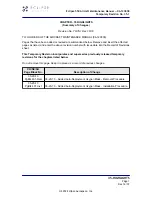
CESSNA AIRCRAFT COMPANY
MODEL 510
MAINTENANCE MANUAL
TAXIING - MAINTENANCE PRACTICES
1.
General
A.
The airplane is controlled with engine thrust, rudder pedal steering, and brakes during the taxi
procedure. The taxi procedure can be done with one or both engines.
B.
Taxi Safety Precautions.
(1)
Personnel that taxi an airplane must be familiar with the airplane and the taxi turn limits. Refer
to Figure 201.
(2)
Make sure that the hydraulic system and the brakes are in a serviceable condition.
(3)
Use only the necessary engine thrust to start movement and to keep the approximate taxi speed.
(4)
Do not use the brakes continuously to keep the correct speed. Adjust the engines as necessary.
(5)
Make sure that the taxi route is clear and free of all blockage, such as maintenance stands and
vehicles.
(6)
Use an observer(s) to make sure that there is wing tip clearance.
(7)
On surfaces with ice, when the nosewheel is turned but has no result, do not let the nosewheel
be turned left or right. Damage to the nose gear can result if a dry area is hit with the wheel in a
turned position.
2.
Taxi the Airplane
A.
The maximum steering angle when the rudder pedals are used is 20 degrees left and right of center.
When the rudder pedals and left/right braking are used together, the maximum angle is limited to 75
degrees left and right of center. Steering during the taxi operation is done by the rudder pedals and
left/right braking. Two-engine operation is recommended during taxi, due to the high thrust necessary
to move the airplane from the parking area.
B.
Prepare the Airplane.
(1)
Clean the area around the airplane.
(2)
Examine the main wheels and remove the static ground cables and the tail stand.
(3)
Make sure that the fuel level in the wings is balanced as much as possible.
(4)
Close all of the access and the baggage doors.
(5)
Disconnect the ground cable.
C.
Taxi the Airplane (Refer to Figure 202).
(1)
Put two personnel in the
f
ight compartment, one in the pilot's seat to taxi the airplane, and one
in the copilot's seat to help and to be an observer.
(2)
Engage the parking brake.
WARNING: Make sure that personnel and equipment are clear of the
engine inlet and the exhaust areas.
(3)
Start the engines. Refer to the Model 510 FAA Approved Airplane Flight Manual.
(4)
Remove the wheel chocks.
(5)
Release the parking brake.
(6)
Make sure that the ground power unit is disconnected.
(7)
Make sure that the taxi personnel know where the airplane will be moved to and what they need
to do.
(8)
Make sure that personnel are clear of the engine inlet and the exhaust areas.
(9)
Use only suf
f
cient thrust to the engines to start to move the airplane. Move the airplane forward
before it is turned.
(10) Do not apply the brakes while the airplane is taxied, decrease the engine thrust to decrease the
taxi speed.
(11) Use the brakes to control the taxi speed, but only use the brakes for a very small quantity of time.
(12) Control the airplane using the rudder pedals.
NOTE:
Nose gear steering is operated with the rudder pedals.
(13) Put personnel at each wing tip to make sure that the wings do not hit any object.
© Cessna Aircraft Company
Aug 30/2006




























